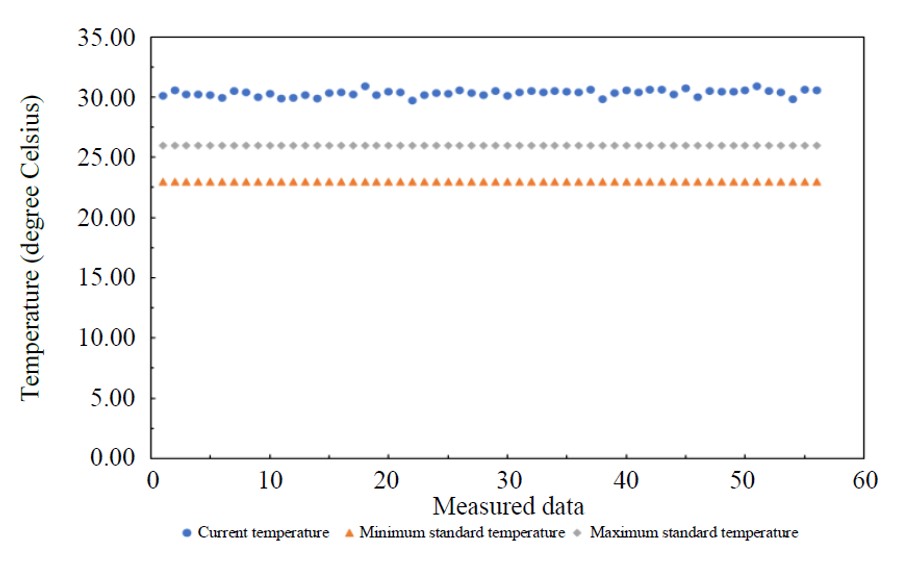Analysis of environmental ergonomic and individual characteristic factors to cloth mask production output in small-medium enterprises
Main Article Content
Abstract
Environmental ergonomics and individual characteristics factors play an important role in the productivity of workers. Environmental ergonomics must be designed to achieve ergonomic working conditions and production targets. A cloth mask manufacturer is one of the small and medium-sized enterprises (SMEs) that faces environmental ergonomics problems concerning achieving the production target. Therefore, this study's objective was to analyze the effect of the workplace environment and individual characteristic factors on cloth mask production output. Data were collected from 8 workers in a cloth mask production station. Furthermore, the correlation between these two factors to cloth mask production output was analyzed by multiple regression analysis. The research hypothesis stated cloth mask production output could be influenced by 6 predictors including lighting intensity and temperature for the workplace environment and age, height, weight, and work experience for individual characteristics. The result showed that lighting intensity, temperature, and age have a significant relationship partially to cloth mask production output. Meanwhile, a combination of all predictors predicted 41 percent of the cloth mask production output variation simultaneously while 59% by other causes. These results confirmed that workplace environment and individual characteristics factors influence the production output in SMEs.
Article Details

This work is licensed under a Creative Commons Attribution-NonCommercial-NoDerivatives 4.0 International License.
This work is licensed under a Creative Commons Attribution-NonCommercial-NoDerivatives 4.0 International License.
References
Ministry of Cooperatives and Small and Medium Enterprises. Perkembangan Data Usaha Mikro, Kecil, Menengah (UMKM) dan Usaha Besar (UB) Tahun 2017 - 2018 [Internet]. Indonesia: Ministry of Cooperatives and Small and Medium Enterprises; 2018 [cited 2020 Dec 10]. Available from: http://www.depkop.go.id/data-umkm. (In Indonesian)
Sauian MS, Kamarudin N, Rani RM. Labor productivity of services sector in Malaysia: analysis using input-output approach. Procedia Econ Financ. 2013;7:35-41.
Ushada M, Okayama T, Murase H. Development of Kansei Engineering-based watchdog model to assess worker capacity in Indonesian small-medium food industry. Eng Agric Environ Food. 2015;8(4):241-50.
Ulfah N, Nurcahyo PJ, Dwiandhono I. Quantitative models of fatigue and workload management for improving productivity of rice milling labors. Kesmas J Kesehat Masy Nas. 2013;7:477-80. (In Indonesian)
Jain R, Meena ML, Dangayach GS, Bhardwaj AK. Association of risk factors with musculoskeletal disorders in manual-working farmers. Arch Environ Occup Health. 2018;73(1):19-28.
Ministry of Manpower. Ministerial regulation number 5 of 2018 concerning occupational safety and health of the work environment. Indonesia: Ministry of Manpower; 2018. (In Indonesian)
Finsen L, Christensen H, Bakke M. Musculoskeletal disorders among dentists and variation in dental work. Appl Ergon. 1998;29(2):119-25.
Rizki ZP, Ushada M, Pamungkas AP. Analysis of environmental ergonomics in rice distribution center. IOP Conf Ser Earth Environ Sci. 2019;355:012025.
Realyvásquez-Vargas A, Maldonado-Macías AA, García-Alcaraz JL, Cortés-Robles G, Blanco-Fernández J. A macroergonomic compatibility index for manufacturing systems. Int J Ind Ergon. 2018;68:149-64.
Kalteh HO, Mokarami H. A macroergonomics perspective for exploring safety culture factors: a qualitative content analysis approach. Int J Occup Saf Ergon. 2022;28(4):2227-37.
Widjanarti MP, Setyawan H, Qadrijati I. The effects of lighting intensity on the productivity of textile workers in Surakarta. J Kesehat Masy. 2019;15(1):39-43.
Katabaro JM, Yan Y. Effects of lighting quality on working efficiency of workers in office building in Tanzania. J Environ Public Health. 2019;2019:3476490.
Akbari J, Dehghan H, Azmoon H, Forouharmajd F. Relationship between lighting and noise levels and productivity of the occupants in automotive assembly industry. J Environ Public Health. 2013;2013:527078.
Börsch-Supan A, Weiss M. Productivity and age: Evidence from work teams at the assembly line. J Econ Ageing. 2016;7:30-42.
Kim H, Lee BS. Aging workforce, wages, and productivity: Do older workers drag productivity down in Korea?. J Econ Ageing. 2023;24:100444.
Calvo-Sotomayor I, Laka JP, Aguado R. Workforce ageing and labour productivity in Europe. Sustainability. 2019;11(20):5851.
Mason T, Sutton M, Whittaker W, Birch S. Exploring the limitations of age-based models for health care planning. Soc Sci Med. 2015;132:11-9.
Walter S, Lee JD. How susceptible are skills to obsolescence? A task-based perspective of human capital depreciation. Foresight STI Gov. 2022;16(2):32-41.
Zhou N, Huang CM, Cai Q, Tzeng OJL, Huang HW. The effects of aging and perceived loneliness on lexical ambiguity resolution. Front Psychol. 2022;13:978616.
Frini O, Jedidia KB. Population age structure change and labour productivity: evidence from Tunisia. Eur J Appl Econ. 2019;16(1):1-19.
Cai X, Lu Y, Wang J. The impact of temperature on manufacturing worker productivity: evidence from personnel data. J Comp Econ. 2018;46(4):889-905.
Parsons KC. Environmental ergonomics: a review of principles, methods and models. Appl Ergon. 2000;31(6):581-94.
Abbasi AM, Motamedzade M, Aliabadi M, Golmohammadi R, Tapak L. The impact of indoor air temperature on the executive functions of human brain and the physiological responses of body. Health Promot Perspect. 2019;9(1):55-64.
Alberto IC, Jiao Y, Zhang X. Too hot or too cold to study? The effect of temperature on student time allocation. Econ Educ Rev. 2021;84:102152.
Martin K, McLeod E, Périard J, Rattray B, Keegan R, Pyne DB. The impact of environmental stress on cognitive performance: a systematic review. Hum Factors. 2019;61(8):1205-46.
Mahdavi N, Dianat I, Heidarimoghadam R, Khotanlou H, Faradmal J. A review of work environment risk factors influencing muscle fatigue. Int J Ind Ergon. 2020;80:103028.
Taylor L, Watkins SL, Marshall H, Dascombe BJ, Foster J. The impact of different environmental conditions on cognitive function: a focused review. Front Physiol. 2015;6:372.
Liu F, Chang-Richards A, Wang KIK, Dirks KN. Indoor environmental factors affecting the productivity of workers in office buildings. IOP Conf Ser Earth Environ Sci. 2022;1101:022001.
Bawa MA. Employee motivation and productivity: a review of literature and implications for management practice. Int J Economics Commerce Manag. 2017;5(12):662-73.
Al-kharabsheh S, Attiany M, Alshawabkeh R, Hamadneh S, Alshurideh M. The impact of digital HRM on employee performance through employee motivation. Int J Data Netw Sci. 2023;7(1):275-82.



